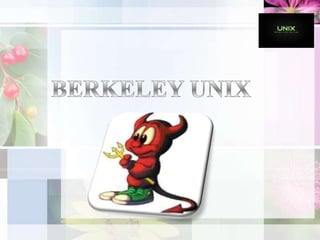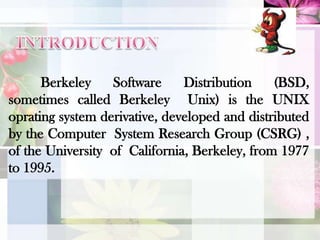Presentation1
- 2. Joan agagad
- 3. INTRODUCTION Berkeley Software Distribution (BSD, sometimes called Berkeley Unix) is the UNIX oprating system derivative, developed and distributed by the Computer System Research Group (CSRG) , of the University of California, Berkeley, from 1977 to 1995.
- 4. BSD Berkeley Software Distribution (BSD, sometimes called Berkeley Unix) is the UNIX operating system derivative developed and distributed by the Computer Systems Research Group (CSRG) of the University of California, Berkeley, from 1977 to 1995.
- 5. The History of BSD 1973 - Ken Thompson/Dennis Richie deliver a paper on UNIX
- 6. Dr. Bob Fabry from Berkeley attends and later obtains a copy of UNIX
- 7. UNIX is installed on several Berkeley PDP/11ŌĆÖs
- 8. Ken Thompson takes a sabbatical at Berkeley, install Version 6 on a PDP/11, and writes a Pascal compilerThe History of BSD1977 - Bill Joy puts together 1st Berkeley Software Distribution (Version 1)
- 9. mid-1978 - 2BSD released with improved Pascal, termcap, vi (about 75 shipped)
- 10. 1978 - Berkeley obtains a VAX-11/780
- 11. A copy of AT&T 32/V UNIX is installed - does not take advantage of virtual memoryThe History of BSD1979 - VAX/BSD distribution assembled includes:
- 12. virtual memory
- 15. Bill Joy ships about 100 tapes of3BSDRAMIL DELA CRUZ
- 16. The History of BSDDARPA becomes interested in BSD
- 17. wants to have common platform (reduced porting costs on different/w and osŌĆÖs)
- 19. UNIX chosen to solidify DARPA userbase
- 20. 1980 - DARPA grants Berkeley 18 month contract to add DARPA contractors featuresThe History of BSD1983 - 4.2BSD is released
- 21. over 1000 shipped - Very popular
- 22. 1986 - 4.3BSD released w/ BSD TCP/IP stack
- 23. AT&T did not have networking/fast file system.
- 24. These were later incorporated into System V using BSD code (which turned out to be a good thing)
- 25. 1988 - 4.3BSD-Tahoe released (machine-independent)The History of BSDUp through the release of 4.3BSD-Tahoe, users were required to purchase an AT&T source license.
- 26. AT&T continued to increase the license cost.
- 27. PC vendors wanted the TCP/IP stack code, so this was split out.
- 28. 1989 - Networking Release 1
- 29. first freely distributed code form Berkeley (open source)The History of BSDearly 1990 - 4.3BSD-Reno released
- 30. virtual memory system from the MACH kernel
- 31. SUN-compatible NFSThe History of BSD1990 - Keith Bostic proposes having BSD become freely-distributed with most source code included
- 32. Bostic pioneers the technique of mass net-based development
- 33. All UNIX utilities re-written from scratch
- 34. Within 18 months, most libŌĆÖs/utilities rewritten
- 35. Karels, Bostic, and McKusick go through kernel, file-by-file rewriting 32/V code and removing it from the release
- 36. 1991 - Networking Release 2 begins distribution
- 37. Several open source groups form to continue the BSD workJOMARI BARBOSA
- 38. The History of BSD1992 - AT&T files suit against Berkeley Software Design Inc. (BSDi)
- 39. BSDi heavily discounts source/binary products over System V
- 40. AT&T suit alleges BSDi products contain USL code/trade secrets
- 41. Counter suit is filed in California
- 42. Berkeley and AT&T end up settling after it turned out AT&T had removed UC-Berkeley copyright notices out of the BSD code (TCP/IP and fast file system) it had incorporated years earlierThe History of BSDBSD groups are formed to work together to maintain and enhance BSD
- 43. NetBSD is focused on supporting as many platforms as possible
- 44. FreeBSD was formed a few months later and focuses on PCŌĆÖs.
- 45. OpenBSD is focused on improving the security of BSD
- 46. Today work continues on BSD through the NetBSD, FreeBSD and OpenBSD distributions.
- 47. These are available via downloading over the internetThe History of BSDWhy BSD was so important
- 48. allowed research environment to grow UNIX
- 49. pioneered internet based open source development
- 50. released programs with code or as code
- 51. Open source has attracted a lot of attention.
- 52. Linux is probably the most well know
- 53. about half of the utilities come from the BSD distributionVariants of UNIXLinuxBSD ŌĆō FreeBSD, NetBSDMac OS X
- 54. Comparison between Network Oss Performance
- 55. JESSICA CHAN
- 56. Comparison between Network Oss Free Applications
- 57. Comparison between Network OssPrice, and Total Cost of Ownership
- 58. Bar chart showing the proportion of users of each BSD variant from a BSD usage survey in 2005.Each participant was permitted to show multiple BSD variants
- 59. Most of the current BSD operating systems are open source and available for download, free of charge, under the BSD License, the most notable exception being Mac OS X. They also generally use a monolithic kernel architecture, apart from Mac OS X and DragonFly BSD which feature hybrid kernels. The various open source BSD projects generally develop the kernel and userland programs and libraries together, the source code being managed using a single central source repository. In the past, BSD was also used as a basis for several proprietary versions of UNIX, such as Sun's SunOS, Sequent's Dynix, NeXT's NeXTSTEP, DEC's Ultrix and OSF/1 AXP (now Tru64 UNIX). Of these, only the last is still currently supported in its original form. Parts of NeXT's software became the foundation for Mac OS X, among the most commercially successful BSD variants in the general market.
- 60. Significant Unix-like Operating System that Descends from BSDDragonFly BSD, a fork of FreeBSD to follow an alternative design, particularly related to SMP.PC-BSD and DesktopBSD, distributions of FreeBSD with emphasis on ease of use and user friendly interfaces for the desktop/laptop PC user.Nokia IPSO (IPSO SB variant), the FreeBSD-based OS used in Nokia Firewall Appliances.Juniper Networks JunOS, the operating system for Juniper routers, a customized version of FreeBSD, and a variety of other embedded operating systemsApple Inc.'s Darwin, the core of Mac OS X; built on the XNU kernel (part Mach, part FreeBSD, part Apple-derived code) and a userland much of which comes from FreeBSDNetApp's ONTAP GX, the operating system for NetApp filers, is a customized version of FreeBSD with the ONTAP GX architecture built on top.NetBSD, an open source BSD with an emphasis on portability and clean design. OpenBSD, a 1995 fork of NetBSD, focuses on portability, standardization, correctness, proactive security and integrated cryptography.
- 61. F5 Networks, All F5 BIGIP Appliances use Free BSD as the underlying OS.DEC's Ultrix, the official version of Unix for its PDP-11, VAX, and DECstation systemsOSF/1, a microkernel-based UNIX developed by the Open Software Foundation, incorporating the Mach kernel and parts of 4BSD Tru64 UNIX (formerly DEC OSF/1 AXP or Digital UNIX), the port of OSF/1 for DEC Alpha-based systems from DEC, Compaq and HP.Early versions of Sun MicrosystemsSunOS (up to SunOS 4.1.4), an enhanced version of 4BSD for the Sun Motorola68k-based Sun-2 and Sun-3 systems, SPARC-based systems, and x86-based Sun386i systems.NeXTNEXTSTEP and OPENSTEP, based on the Mach kernel and 4BSD; the ancestor of Mac OS X386BSD, the first open source BSD-based operating system and the ancestor of most current BSD systemsDEMOS, a Soviet BSD cloneBSD/OS, a (now defunct) proprietary BSD for PCs
- 62. Free BSDFreeBSD is developed as a complete operating system. The kernel, device drivers and all of the userland utilities, such as the shell, are held in the same source code revision tracking tree, whereas with Linux distributions, the kernel, userlandutilities and applications are developed separately, then packaged together in various ways by others.End of Discussion
- 63. PRESENTED BY:JESSICA CHANJOAN AGAGADRAMIL DELA CRUZJOMARI BARBOSA




























